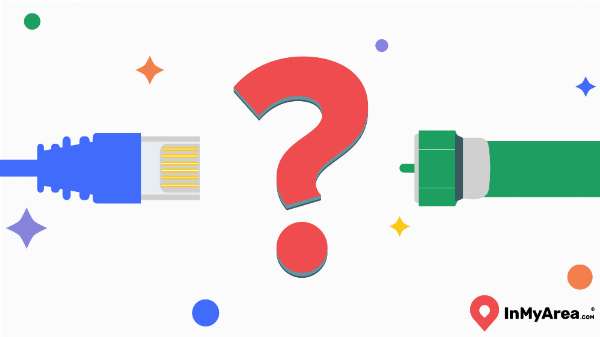- DSL is generally more affordable, but while cable costs more, it performs better.
- Cable internet is significantly faster than DSL and can reach gigabit speeds.
- If you need smooth online gaming or 4K streaming, cable is the better choice due to lower latency and faster speeds.
Choosing the right internet connection can be like picking the perfect pair of shoes — it depends on your needs, lifestyle and budget. Two wired internet connections that are available almost everywhere are DSL and cable. But what sets the two apart, and how do you know which is better? Let's compare DSL vs. cable to help you stay connected without stretching your budget.
DSL vs. Cable: What's the Difference?

The major difference between DSL (Digital Subscriber Line) and cable is how they deliver data to your home. DSL uses existing telephone lines, while cable internet relies on coaxial TV cables. The delivery methods affect speed, reliability and availability. Let's compare their features side-by-side.
Feature | DSL | Cable |
|---|---|---|
Download speed | 1-150 Mbps | 25-1,500 Mbps |
Upload speed | 1-10 Mbps | 5-10 Mbps |
Latency | Lower than satellite, but higher than cable | Lower than DSL |
Reliability | High, especially in rural areas | High |
Cost | $20-$70 per month | $20-$120 per month |
Availability | 90% of the U.S. | 87% of the U.S. |
Data Caps | Yes, depending on the provider | Yes, depending on the provider |
Pros and Cons of DSL Internet
DSL internet is a popular choice if you need a reliable connection without breaking the bank. However, it does come with limitations. DSL can meet your needs if you primarily browse the web and stream content on a few devices, but it may not be ideal for households with heavy internet usage.
Pros | Cons |
|---|---|
More affordable than cable | Slower speeds compared to cable and fiber |
Dedicated connection unaffected by neighborhood usage | Speed decreases with distance from the ISP |
Wide availability, even in rural areas | Higher latency than cable, affecting gaming and video calls |
Can be bundled with home phone services | Less potential for future upgrades compared to cable |
Pros and Cons of Cable Internet
Cable internet offers higher speeds and lower latency than DSL, but it has its own set of trade-offs. However, if you need a faster connection, cable is a better option, especially in areas with strong infrastructure.
Pros | Cons |
|---|---|
Much faster than DSL, with gigabit availability | Can slow down during peak usage times |
Suitable for online gaming and video calls | Higher cost, especially for premium plans |
Lower latency compared to DSL | Shared bandwidth with neighbors |
Greater potential for future upgrades, including speed increases | Availability may be limited in rural areas |
Does DSL or Cable Meet Your Needs?

Choosing between DSL and cable internet depends on your needs, from speed requirements to budget concerns. Let’s break it down.
Faster Internet Connection
Cable internet is significantly faster than DSL, with speeds ranging from 25 Mbps to over 1 Gbps. Even with occasional slowdowns during peak hours, cable provides a more seamless experience for streaming, gaming, and working from home. DSL speeds top out at around 150 Mbps, which works for light browsing and single-device streaming but isn't ideal if you're doing more online.
Better Choice for Gamers
Gamers require fast download speeds, low latency and stable connections. Cable internet provides lower latency and faster speeds, making it far superior for online gaming. DSL can work for casual gamers, but if you play competitive multiplayer games, you'll experience lag and slower response times.
Most Affordable
DSL internet is on the cheaper side, with plans starting at just $20 per month. While cable internet plans can be as low as $20 per month, you get what you pay for. Higher speed connections will be more in the middle of the $20-$120 average range, with faster speeds costing more. If budget is a primary concern and high-speed connectivity isn’t necessary, DSL could be more cost-effective.
Equipment and Installation Costs
Both DSL and cable require a modem and a router. ISPs often rent modems for about $5-$10 per month, depending on who you go with. But purchasing your own can save money in the long run. Modems can range between $50-$125 and routers can cost between $75-$200. Installation fees vary, but some providers offer free setup promotions, so we recommend shopping around to see if you can take advantage of any deals.
Availability
DSL is more widely available, particularly in rural areas, because it uses existing phone lines. Cable internet is more available in urban and suburban areas but may not be an option in remote areas. Both feature widespread availability across the country, covering 90 percent of the U.S. By comparison, fiber only covers about half of the country.
Internet Caps
Both DSL and cable providers may impose data caps, though some providers offer unlimited plans. If your internet use is heavy — such as streaming 4K content or gaming — you should look for an unlimited plan to avoid additional fees or speed throttling.
DSL vs. Cable: How to Choose
The right choice depends on your priorities. If affordability and availability are most important, DSL is a solid choice. If speed and performance matter more, cable internet is likely the better option. Consider your household's internet usage habits before making a decision. It's also worth noting that cable has better future-proofing compared to DSL, making it a better choice in the long run.
Frequently Asked Questions About DSL vs. Cable Internet
Is DSL outdated?
DSL is still widely used, particularly in rural areas, but it's gradually being phased out in favor of faster fiber and cable technologies. Some providers are discontinuing DSL services in favor of more modern alternatives, but it remains a viable wired internet option if cable and fiber aren't available.
How do I know if my internet is DSL or cable?
Check your modem and service provider details. DSL connections use a phone line and require a DSL modem, while cable internet connects via a coaxial cable and uses a cable modem. Your ISP’s website or customer support can confirm your service type.
Is a dial-up modem the same as DSL?
No, the two aren't the same. Dial-up uses analog phone lines and is significantly slower, often maxing out at 56 Kbps. DSL uses digital signals over phone lines and provides much faster speeds, typically starting at 1 Mbps or higher. For reference, 1 Mpbs is equivalent to 1,000 Kbps.
Is fiber-optic really better than cable?
Fiber-optic internet offers faster speeds, lower latency and better reliability compared to cable. However, availability is limited, and installation costs can be higher. If fiber is available in your area, it's the best choice for high-speed, future-proof internet.


